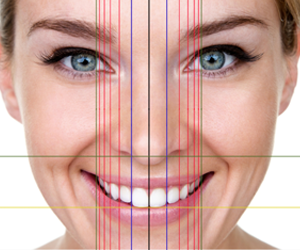COMPONENTS OF AN ESTHETIC SMILE
Harmonizing an esthetically perfect smile requires a perfect integration of facial composition and dental composition. The facial composition includes the hard and soft tissues of the face. The dental composition relates more specifically to teeth and their relationship to gingival tissues. Moreover a smile design should always include the evaluation and analysis of both facial and dental composition.
Facial components
Facial beauty is based on standard esthetic principles that involve proper alignment, symmetry and proportion of face. In other words Analyzing, evaluating and treatment planning for facial esthetics often involve a multiple approach which could include orthodontics, orthognathic surgery, periodontal therapy, cosmetic dentistry and plastic surgery.
There are two facial features which do play a major role in the for a Perfect smile design:
- The interpupillary line.
- Lips .
THE INTERPUPILLARY LINE :-
The interpupillary line should be perpendicular to the midline of the face and parallel to the occlusal plane.
LIPS:-
Lips create the boundaries of the smile design.
DIMENSIONS OF FACE For A Perfect Smile.
The horizontal and vertical dimensions for an ideal face are as follows:
Horizontal:
- The width of the face should be the width of five eyes.
- The distance between the eyebrows and chin should be equal to the width of the face.
Vertical:
- The facial height is divided into three equal parts from the fore head to the eyebrow line, from the eyebrow line to the base of the nose and from the base of the nose to the base of the chin.
- The full face is divided into two parts, eyes being the midline.
- The lower part of the face from the base of the nose to the chin is divided into two parts, the upper lip forms one-third of it and the lower lip and the chin two-thirds of it.
The basic shape of the face when viewed from the frontal aspect can be one of the following:

- Square.
- Tapering.
- Square tapering.
- Ovoid.
The lateral profile of an individual can be any one of the following:
- Straight.
- Convex.
- Concave.
These factors play a role in determining the tooth size, shape and the lateral profile, the tooth morphology is dependent on the facial morphology.
VITAL ELEMENTS OF PERFECT SMILE DESIGNING (DENTAL COMPOSITION)
The vital elements of a perfect smile designing include the following:
TOOTH COMPONENTS

- Dental midline.
- Incisal lengths.
- Tooth dimensions.
- Zenith points.
- Axial inclinations.
- Interdental contact area and point.
- Incisal embrasure.
- Sex, personality and age.
- Symmetry and balance.
SOFT TISSUE COMPONENTS
- Gingival health.
- Gingival levels and harmony.
- Interdental embrasure.
- Smile line.
Tooth component of Perfect Smile design/smile correction.
DENTAL MIDLINE:
The midline refers to the vertical contact interface between two maxillary centrals. Besides it should be perpendicular to the incisal plane and parallel to the midline of the face. Minor discrepancies between facial and dental midlines are acceptable and, in many instances, not noticeable. However, a canted midline would be more obvious, and therefore, less acceptable. The maximum allowed discrepancy can be 2mm and sometimes greater than 2mm discrepancy is esthetically acceptable so long as the dental midline is perpendicular to the interpupillary line.
Various anatomical landmarks such as midline of the nose, forehead, chin, philtrum, interpupillary plane can be used as guides the midline.The philtrum of the lip is one of the most accurate of these anatomical guide posts. It is always in the center of the face except in surgical, accident, or cleft cases. The center of the philtrum is the center of cupids bow and it should match the papilla between the centrals. If these two structures match and the midline is incorrect, then the problem is usually incisal inclination. If the papilla and philtrum do not match,then the problem is a true midline deviation. A midline that does not bisect the papilla is more noticeable than the one that does not bisect the philtrum.
To evaluate the midline, one must always consider;
- Location
- Alignment
- Midline should be parallel to the long axis of the face: the line angle that forms the contact between the centrals should be parallel to the long axis of the face.
- Perpendicular to the incisal plane: the line angle that forms the contact between the centrals should be perpendicular to the incisal plane.
- Over the papilla: the midline should drop straight down from the papilla.
A face bow transfer or even a reference stick aligned parallel to the interpupillary plane provides useful information in laboratory communication regarding midline inclination and the possible presence of a canted incisal plane.
Maxillary and mandibular midlines do not coincide in 75% of cases. Therefore, it is not advisable to use the mandibular midline as a reference point for establishing the maxillary midline. A mismatch between maxillary and mandibular midline does not affect esthetics since mandibular teeth are not usually visible while smiling.
Incisal lengths (incisal edge positions)
Maxillary incisal edge position is the most important determinant in smile creation because once set, it serves as a reference point to decide the proper tooth proportion and gingival levels. In other words The parameters used to help establish the maxillary incisal edge position;
- Degree of tooth display
- Phonetics
- Patient input
Degree of tooth display: When the mouth is relaxed and slightly open, 3.5mm of the incisal third of the maxillary center incisor should be visible in a young individual. As age increases, the decline in the muscle tonus results in less tooth display.
Phonetics: Phonetics is a major determinant of tooth length. In order to determine proper lip, tongue and incisal support and tooth position, it is necessary that the patient sits either erect or stands during the phonetic exercises.
Patient input: Intraoral cosmetic preview and provisional restorations helps to confirm proper placement of the final incisal edge position. The patient desires must be met as best as possible, provided they do not interfere with the parameters previously discussed.
Correct incisal edge position is crucial because it is related to the pitch of the anterior teeth, labial contours, lip support, anterior guidance, lingual contours and tooth display. The pitch of each anterior tooth is determined by the combination of correct lip support and the lingual labial position of the incisal edge. This location influences anterior guidance and the labial and lingual contours.
Tooth Dimensions
Tooth dimensions correct dental proportion is related to facial morphology and is essential in creating an esthetically pleasing smile. Central dominance dictates that the centrals must be the dominant teeth in the smile and they must display pleasing proportions. They are the key to the smile. The proportions of the centrals must be esthetically and mathematically correct. Furthermore the width to length ratio of the centrals should be approximately 4:5.In addition the shape and location of the centrals influences or determines the appearance and placement of the laterals and canines.
- Golden proportion (Lombardi): When viewed from the facial, the width of each anterior tooth is 60% of the width of the adjacent tooth (mathematical ratio being 1.6:1:0.6). It is difficult to apply as patients have different arch form, lip anatomy and facial proportions. Strict adherence to golden proportion calculations limits creativity and this may lead to cosmetic failure.
- Recurring esthetic dental proportion (Ward):The successive width proportion when viewed from the facial aspect should remain constant as we move posteriorly form midline. This offers great flexibility to match tooth properties with facial proportions.
- M proportions (method): This method compares the tooth width with facial width using a software. The whole analysis is done in the computer and hence involves more of mathematics rather than artistic analysis.
- Chu’s esthetic gauges: Dr. Chu’s research supports Levin’s Red concept and refutes the golden proportion. A series of gauges are available to make intraoral analysis easier. The gauges allow for;
- Fast, simple analysis and diagnosis of tooth width problems, tooth length problems and ginigival length discrepancies.
- Colour coding predefines desired tooth proportions, quicker and easier to read than any other instrument.
- Used as a reference guide between clinician and lab technician, hence reduces the incidences of miscommunications errors.
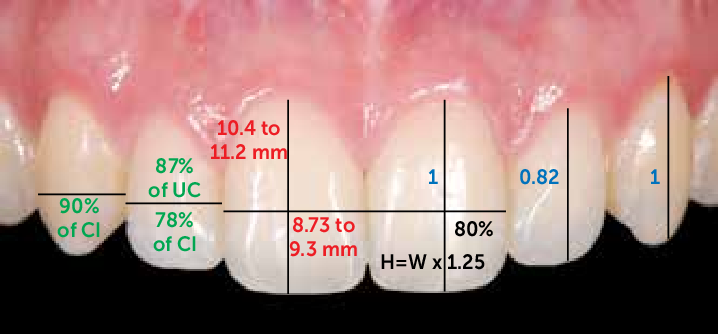
The factors guiding individual tooth for perfect smile dimensions are as follows;
- Maxillary central incisor: centrals are the focal point of an esthetic smile and create the central dominance as described earlier. Approximate length of the central should be 10-11mm and the width is calculated accordingly so that the ratio falls between 75 and 80%.
- Maxillary canine: They play a critical point in creating a pleasing smile as they are;
- The junction between the anterior and posterior dental segments; hence, only the mesial half of the canine is visible from the frontal view when the patient smiles
- Support the frontal muscles – the size and characteristic of the buccal corridor is determined by the size, shape and position of the canine.
- Canine depicts the personality characterization (masculine: vigorous and aggressive; feminine: delicate and soft).
Consider this;
- Central incisor is wider than the lateral by 2-3 mm and canine by 1-1.5mm
- Canine is wider than the lateral by 1-1.5mm
- Canine and central \ are longer than lateral by 1-1.5mm.
- Maxillary bicuspids: They play a very important role for arch design. They should fill the buccal corridor. Buccal corridor refers to dark space (negative space) visible during smile formation between the corners of the mouth and the buccal surfaces of the maxillary teeth. It appearance is influenced by;
- The width of the smile and the maxillary arch
- The tone of the facial muscles
- The positioning of the labial surface of the upper premolars
- The prominence of the canines particularly at the distal facial line angle
- Any discrepancy between the value of the premolars and the six anterior teeth.
Arch form has a direct influence on the buccal corridor. Apart from the ideal arch is broad and conforms to a U shape. A narrow arch is generally unattractive, negative space should be kept to minimum. This problem can be solved or minimized by restoring the premolars. The buccal corridor should not be completely eliminated because a hint of negative space imparts to the smile a suggestion of depth Ultimately, there is no formula for anterior esthetics; instead, the.
final esthetics is a combination of;
- Tooth proportion guide lines
- Patient’s own perception
- Cultural and social influence
- Dentist artistic influences
- Effective communication with laboratory
Zenith points
Zenith points are the most apical position of the cervical tooth margin where the gingiva is most scalloped. An instance Its located slightly distal to the vertical line drawn down the center of tooth. The lateral is an exception as its zenith point may be centrally located. Evidently establishing the proper location of zenith points is a critical step in alteration of mesial and distal dimensions
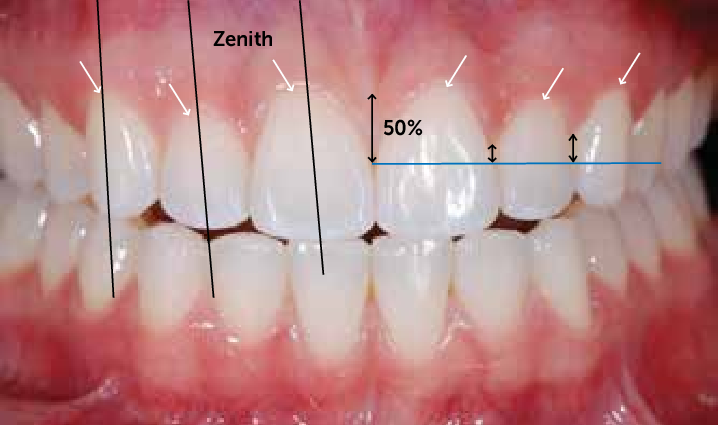
- Closure of diastema: Move the zenith points
- Provides the illusion of bodily movement and reduce exaggerated triangular form
- Correction of tooth angulation
Tooth inclinations
Axial inclination the vertical alignment of maxillary teeth, visible in the smile line, to central vertical midline. From the central to the canine, there should be natural, progressive increase in the mesial inclination of each subsequent anterior tooth. It should be least noticeable with the centrals and more pronounced with the laterals and slightly more so with the canines. If the incisal plane is canted, the axial inclination of the anterior teeth and the midline itself, if it is right angle to the incisal plane, will be correspondingly incorrect. Axial inclination can also refer to the degree of tipping in any plane of reference.
The guide for labiolingual inclination is as follows affects perfect smile ;
- Maxillary central incisor – positioned vertically or slightly labial
- Upper lateral incisor- cervical is tucked in, incisal edge inclined slightly labially
- Maxillary canine-cervical area positioned labially, cusp tip lingually angulated
Interdental contact area point
- Interproximal contact area ( ICA ):
- A broad zone in which two adjacent teeth touch.
- It follows the 50:40:30 rule in reference to the maxillary central incisor.
- The increasing ICA helps to create the illusion of longer teeth by wider and also extend apically to eliminate black triangles.
Interproximal contact point ( ICP ):
As a general rule, the ICP moves apically, the further posterior one moves from the midline.
Incisal Embrasures
The incisal embrasures should display a natural, progressive increase in size or depth from the centrals to the canine. This is a function of the anatomy of these teeth and as a result, the contact point moves apically as we proceed from central to canine. Besides the contact points in their apical progression should mimic the smile line. Leads to provide adequate depth and variation to the incisal embrasure will plays an important role in providing a perfect smile ;
- Make the teeth appear too uniform
- Make the contact areas too long and impart to the dentition a box like appearance. if incisal embrasures are not properly developed the individuality of the incisors will loss
Also, if the incisal embrasures are too deep, it will tend to make the teeth look unnaturally pointed. As a rule, a tooth distal to the incisal corner is more rounded than its mesioincisal corner.
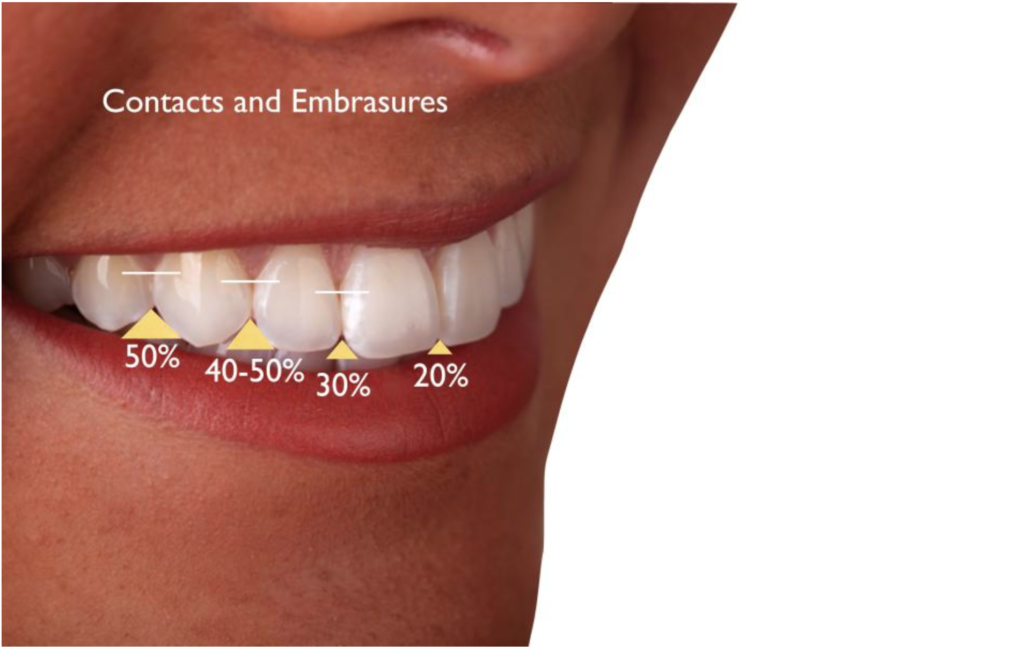
Sex, Age and Personality
Differences in the length, shape and positioning of the maxillary teeth allow for dramatic characterization.
- Age – maxillary central incisor
Youthful teeth: unworn incisal edge, defined incisal embrasure, low chroma, and high value.
Aged teeth: shorter; so less smile display, minimal incisal embrasure, high chroma, and low value
- Sex – maxillary incisors
Female form: round smooth, soft delicate
Male form: cuboidal, hard vigorous
- Personality- maxillary canine
Aggressive, hostile angry: pointed long “fangy” cusp form passive, soft: blunt, rounded. short cusp form in canine.
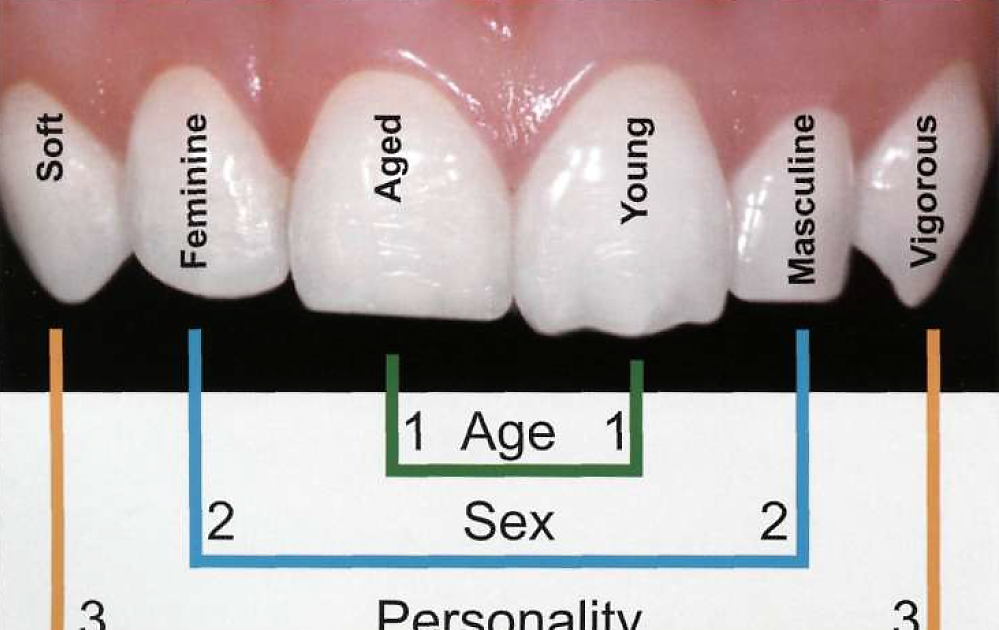
Symmetry and balance
Symmetry is the harmonious arrangement of several elements with respect to each other. Symmetrical length and width are most crucial for the centrals. It becomes less absolute as we move further away from the midline.
- Static symmetry: mirror image, maxillary central incisors.
- Dynamic symmetry: two objects very similar but not identical. Playing with perfect imperfection in the laterals and canines allows for a more vital, dynamic, unique and natural smile. Balance is observed as the eyes move distal from the midline, so that both the right and left sides of the smile are well balanced.
Soft tissue component of a perfect smile designing
Gingival healt
The gingiva acts as the frame for the teeth; gingival health affects final esthetic success of the case greatly by the It is of paramount importance that the gingival tissues are in a complete state of health prior to the initiation of any treatment.
Healthy gingiva is usually.
- Pale pink in color , stippled , firm and it should exhibit a matte surface;
- Located facially- 3 mm above. Further more located interdentally – 5 mm above the intercrestal bone papilla should be pointed and should fill the gingival embrasure right up to the contact area.
Gingival level and harmony to have a perfect smile
Establishing the correct gingival levels for each individual tooth is the key in the creation of harmonious perfect smile smile. The cervical gingival height (position or level ) of the centrals should be symmetrical. It can also match that of the canines. Indeed It is acceptable for the laterals to display the same gingival level.
However, the resultant smile may be too uniform and it is preferable to exhibit a rise and fall in the soft tissue by having the gingival contour over the laterals located toward the incisal resultant may be too uniform and it is preferable to exhibit a rise and fall in the soft tissue by having the gingival contour over the laterals located toward the incisal compared to the tissue level of the centrals and canines. The gingival margin of the lateral incisor is 0.5-2.0mm below that of the central incisors. For instance desirable gingival placement over the laterals is for it to be apical to that of the centrals and or the canines.
The gingival shape on the mandibular incisors and the maxillary laterals should exhibit a symmetrical half oval or half circular shape. The maxillary centrals and canines should exhibit a gingival shape that is more elliptical.
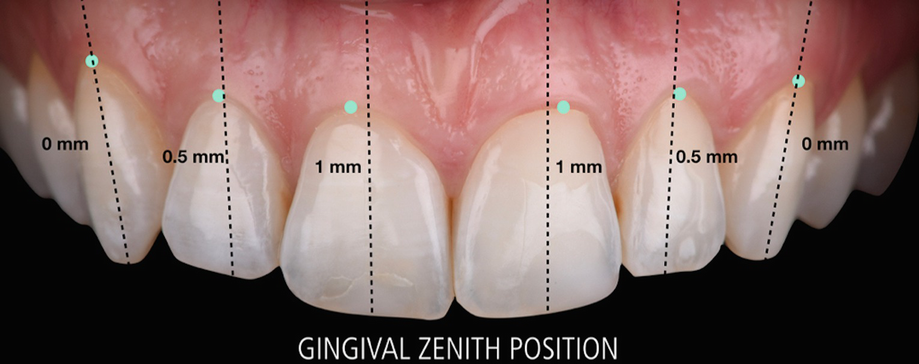
Interdental embrasure (cervical embrasure) contribute a perfect smile
The darkness of the oral cavity should not be visible in the interproximal triangle between the gingiva and the contact area. If the most apical point of the restoration is 5mm or less from the crest of the bone, then black triangles will be avoided. At times, this will require long contact area that will be extended toward the cervical. This will encourage the formation of a healthy, pointed papilla instead of blunted tissue form that often accomplishes a black triangle. Conversely, an improperly developed cervical embrasure that involves overextended, bulky restorations will result in an improper emergence profile and swollen and inflamed gingival tissues ,hence cervical embrasure also involved in perfect smile.
Smile line
Smile line refers to an imaginary line along the incisal edges of the maxillary anterior teeth which should mimic the curvature of the superior border of the lower lip while smiling. Another frame of reference for the smile line suggests that the central should appear slightly longer or, at least, not any shorter than the canines along the incisal plane also contributes perfect smile .
The Lip line not confused with the smile line. It refers to the position of the inferior border of the upper lip during smile formation and thereby determines the display of tooth or gingiva at this hard and soft tissue interface. In other words Under ideal conditions, the gingival margin and the lip line should be congruent or there can be a 1-2mm display of the gingival tissue. In addition showing 3-4mm or more of the gingiva (gummy smile) often requires cosmetic periodontal recontouring to achieve an ideal result.
What are the benefits of a Perfect smile makeover?
The benefits of a perfect smile makeover can be health benefits as well as aesthetic ones.
The aesthetic benefits include:
- Teeth, looking and feeling much better beautiful smile which will make you look much better. Consequently better self- confidence and wellbeing.
- Health benefits include: Teeth that are easier to clean and take care of less risk of decay and infections.


